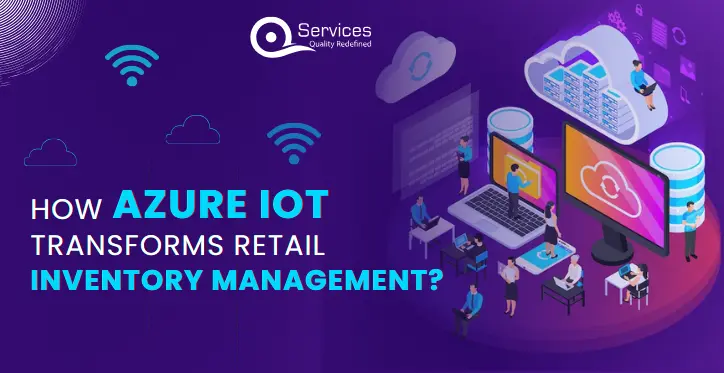Home » How Azure IoT transforms Retail Inventory Management

From big malls to local shops, every business, especially in retail, is going through a digital makeover. Modern technologies like AI, Big Data, Machine Learning, and IoT are driving a massive digital transformation in the retail industry, completely changing how businesses operate and engage with their customers. Among these revolutionary dynamics, the global Internet of Things (IoT) in retail has become a major performer, shaping the future of inventory management and customer experiences.
The global IoT in retail market, estimated to be valued at USD 42.38 billion in 2022, showed the considerable impact of IoT solutions on the retail industry. Even more remarkable are the forecasts for the future, with a compound annual growth rate (CAGR) of 28.4% between 2023 and 2030. These numbers demonstrate the growing recognition of IoT’s ability to change the retail sector by providing dynamic modifications in the ways that businesses interact with their inventory and optimise their processes.
Retail inventory management is a systematic approach used by retail businesses to keep an eye on and control the entire collection of goods they sell. It entails carefully arranging the purchasing, storing, and distributing processes to accomplish a balance between supply and demand. This strategic discipline serves to reduce the possibility of overstocking or stockouts by ensuring that merchants have an adequate supply of popular items.
Get free Consultation and let us know your project idea to turn into an amazing digital product.
In the retail industry, inventory management is essential to overall business growth, customer satisfaction, and operational efficiency. Retailers who understand the strategic importance of efficiently managing their inventory have a better ability to cope with the difficulties brought by the ever-changing retail environment.
In retail, Azure IoT apps change the way people shop. Let’s look at how Microsoft Azure IoT is making headlines in the retail sector.
Azure IoT provides a smart edge to in-store analytics by leveraging devices that are Wi-Fi or Bluetooth-connected. Positioned sensors transmit data on product availability and location in real time to Azure IoT Central. This unified platform enables robust data analysis, giving retailers significant insights into consumer behaviour and assisting them in making strategic decisions about product selection and shop arrangement improvements.
Azure IoT, a cornerstone of cloud computing for retail, with its robust ecosystem, enables retailers to monitor inventory levels in real-time. IoT-enabled devices seamlessly connect with Azure services, providing a continuous stream of data on stock levels. This real-time visibility equips retailers to make data-driven decisions, from precisely timing restocking activities to determining optimal order quantities. Beyond the immediate benefits, Azure’s analytical prowess harnesses this data to unravel customer purchasing trends, facilitating more accurate predictions of future demand.
Azure IoT extends its reach to connected logistics, enabling real-time tracking of shipments. IoT tags on cargo send data to Azure IoT Central, providing insights into location, temperature, and humidity. This cold chain monitoring ensures the safety of temperature-sensitive products throughout their journey. Azure cloud for retail services process and analyse the data, offering valuable insights for businesses.
Azure IoT comes into play for energy management in retail. Azure-enabled smart devices, equipped with sensors, gather data on energy consumption and potential emergencies like power cuts. This data is sent to Azure IoT Central for processing which facilitates communication between sensors and gateways, allowing for real-time alerts and actions. Through this retail can now monitor and manage energy usage efficiently, reducing costs and ensuring a reliable shopping environment.
Azure IoT provides a smart security layer that is highly beneficial in preventing theft in retail stores. Due to RFID and GPS technologies, devices create virtual perimeters around specific areas of a store. Azure IoT sends out an alert upon any departure, enabling quick and precise action. This device lowers theft-related losses and enhances security measures thanks to its potent deterrence effect.
Sensor-enabled shopping carts enhance consumer engagement through the integration of Azure IoT, playing a pivotal role in retail store digital transformation. With a variety of sensors, these smart carts can gather precise data regarding customer movements and in-store experiences. Azure’s cloud architecture collects, stores, and evaluates this information to provide businesses with in-depth understanding of customer behaviour. The application of this knowledge forms the foundation for improving customer experiences and tailoring retail environments to meet evolving consumer needs.
Begin the integration process by conducting a comprehensive analysis of your retail operations, including a focus on your cloud-based POS system. Identify specific pain points in inventory management and set clear objectives for improvement. Whether it’s enhancing real-time visibility, reducing stockouts, or improving overall operational efficiency, a well-defined set of objectives will guide your entire IoT implementation strategy.
Azure offers a robust suite of cloud managed IoT services. Opt for the Azure IoT Hub to effectively manage your devices, ensuring secure and seamless communication. Explore Azure IoT Central, a user-friendly platform for comprehensive application management. Additionally, consider integrating Azure Stream Analytics for real-time data processing, enabling insightful analytics from the continuous stream of IoT data.
Carefully choose IoT devices tailored to your inventory management needs. Consider factors such as temperature and humidity monitoring and verify compatibility with Azure IoT. Ensure that selected devices can reliably transmit data securely to the Azure cloud, forming a foundation for accurate and efficient data collection.
Leverage the Azure IoT Hub for efficient device provisioning and management. This involves registering each IoT device, assigning them to specific IoT hubs, and implementing robust security measures. Authenticate and authorise devices to establish secure communication channels, mitigating potential security threats.
Configure Azure IoT Hub or Azure IoT Central to seamlessly ingest data from your IoT devices. Choose appropriate Azure data storage solutions, such as Azure Blob Storage or Azure SQL Database, to ensure secure and organised storage of collected data. This step lays the foundation for efficient data accessibility and analysis.
Set up Azure Stream Analytics to process and analyse data in real-time. Define queries and transformations that extract meaningful insights from the continuous stream of IoT data. Real-time analytics are critical for making informed decisions, especially in the context of dynamic inventory monitoring and management.
Ensure seamless integration with existing retail systems, including point-of-sale (POS), ERP, and CRM. Azure IoT should complement and enhance your overall retail infrastructure, providing a unified view of operations. Integration ensures smooth data flow between systems, allowing for a comprehensive understanding of your retail environment.
Prioritise security in your IoT implementation. Utilise Azure IoT’s security features, including role-based access control, device authentication, and encryption. These measures safeguard data transmission and storage, protect sensitive information from potential security threats, and ensure compliance with industry regulations.
Consider developing custom applications to visualise and interact with IoT data, depending on specific business requirements. Utilise Azure IoT SDKs for popular programming languages or explore Azure IoT Central for a no-code/low-code approach. Custom applications enhance the user experience and provide tailored insights.
Implement monitoring tools within Azure to track the performance of your IoT solution for retail. Set up alerts for anomalies or issues, and regularly review and optimise your IoT implementation based on insights gained from data analytics. Continuous monitoring ensures the ongoing efficiency and reliability of your IoT infrastructure.
Conduct thorough training sessions for your staff on the new IoT-enabled processes. Ensure employees are comfortable with the technology and understand how it enhances their daily tasks. Address any change management concerns to facilitate a smooth transition, fostering positive adoption of the new system.
Plan for scalability as your business grows. Azure provides scalable solutions, but it’s essential to periodically reassess your requirements. Adjust your IoT infrastructure to accommodate increasing data volume and device connections, ensuring seamless scalability to meet evolving business needs.
By following this structured guide, you can navigate the integration of Azure IoT into retail inventory management, optimise operations, and harness the full potential of IoT for retail business growth.
Retailers often find themselves caught between their IoT aspirations and the practical challenges of implementation. While the potential of IoT is acknowledged, a lack of concrete data to justify its adoption poses a hurdle. Surveys indicate that a significant percentage of top retailers struggle to present compelling business cases for IoT in specific scenarios. Bridging this gap requires a deeper understanding of IoT’s tangible advantages and applications in the retail landscape.
As IoT adoption rises, so does concern over security breaches. A substantial number of companies report breaches in their IoT systems, emphasising the need for robust security measures. For retailers, dealing with vast amounts of data becomes a potential target for cyber threats. The interconnected nature of IoT devices amplifies the risk. Addressing this challenge involves a proactive approach to security, ensuring end-to-end protection of IoT systems.
The substantial investment required for large-scale IoT implementation often poses a barrier for retailers. Integrating diverse devices, sensors, and networks comes with associated costs. Initial expenditures for hardware, software, and infrastructure procurement can be daunting, especially for retailers with extensive operations. The ongoing costs of maintenance, upgrades, and data management add to the adoption challenges. Retailers seek clear evidence of real-world applications demonstrating direct benefits, such as increased revenue and cost reduction, to justify the investment.
Interoperability emerges as a significant hurdle for retailers entering the IoT landscape. The diverse range of IoT devices and applications complicates communication and data exchange, hindering the creation of a cohesive IoT infrastructure. Retailers must strategically address this issue by investing in standardised protocols and open APIs. Ensuring seamless communication across devices and media differences becomes pivotal for a unified IoT ecosystem.
As retailers expand their IoT footprint, scalability becomes a critical concern. The existing infrastructure may struggle to handle the escalating data volume and device connections. This can lead to resource shortages, affecting the smooth operation of IoT networks. Proactive planning and investment in scalable IoT solutions are imperative, ensuring flexibility to meet growing demands and adaptability to evolving business needs.
Retailers grapple with the challenge of maintaining consistent connectivity for their myriad IoT devices. In a retail environment with numerous sensors and devices reliant on continuous connections, dead spots or network congestion can disrupt operations. Addressing connectivity hurdles involves exploring redundancy options, backup connectivity measures, and local data caching. These measures ensure that IoT devices operate seamlessly, providing uninterrupted decision-making insights.
The data deluge from IoT devices poses a challenge in processing, analysing, and deriving actionable insights. Retailers must invest in advanced data analytics tools to make sense of the data generated. Extracting valuable insights becomes crucial for understanding customer behaviour, optimising operations, and staying ahead in the competitive retail landscape.
Integration becomes a puzzle for retailers as traditional systems may not seamlessly align with IoT technology. Planning and tailoring the integration process to ensure harmony between old and new technologies is essential. Flexible middleware emerges as a valuable ally, facilitating smoother integration and overcoming compatibility, data, and operational challenges.
Managing a diverse range of IoT devices adds complexity to everyday operations for retailers. Each device has unique configurations and maintenance needs, contributing to operational challenges. Proactive management, including regular updates, patches, and adherence to security protocols, becomes imperative. This ensures the smooth and efficient functioning of the IoT ecosystem.
Finding the right IT partner emerges as a significant challenge for retailers embarking on IoT initiatives. The dynamic nature of IoT technologies necessitates a consulting partner with extensive experience in enterprise-level IoT projects. This strategic partnership becomes akin to finding a reliable navigator in the intricate world of IoT, guiding retailers towards successful deployments, and staying at the forefront of technological advancements.
Evaluating the impact of Azure IoT on retail inventory management is a remarkable experience. The most significant observation is that retailers’ business models are going to undergo a significant transformation that will mark a significant turning point in the industry’s growth. It is predicted that IoT technology will become widely used in the future, bringing with it benefits like better supply chain and product handling efficiency and higher levels of customer satisfaction. Retailers who ignore this innovation risk slipping behind their rivals. The article’s focus is on the power of data, showing how astute retailers can use insights to predict product availability, give discounts, and influence customer decisions. This proactive strategy guarantees accurate inventory control while reducing losses.
Retailers can take benefit of numerous Internet of Things advantages, ranging from invaluable insights to continuous monitoring and real-time tracking. With these resources at their disposal, retailers can easily enhance the customer experience, which will eventually lead to increased sales.

Content writer
INDIA : F-190, Phase 8B, Industrial Area, Sector 74,
Mohali, India
CANADA : 55 Village Center Place, Suite 307 Bldg 4287, Mississauga ON L4Z 1V9, Canada
USA :2598 E Sunrise Blvd, Fort Lauderdale,FL 33304,
United States

Founder and CEO

Chief Sales Officer
